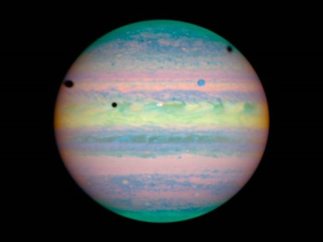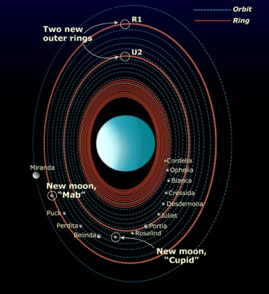WHAT’S UP Many Moons
With the August 21st eclipse looming, I have started to wonder about solar eclipses on other planets. Is Earth unique among planets in our solar system? What might we see if we could stand on other worlds?
In a way, Earth is unique among planets, having a moon that appears essentially the same size in the sky as the sun. The sun’s diameter is about 1.39 million km and it is about 149.6 million km away. The moon’s diameter is about 3474 km and it is about 384,400 km away on average. Doing the math, we can see that the ratio of size to distance for the sun and moon are about equal. So, they appear roughly the same size in the sky, about ½ degree (1/2 the width of your pinky finger when held at arm’s length). This interesting coincidence is not present for any other planet in our solar system and, I should note, it will not always be present for us (see “What’s Up: The Very Last Solar Eclipse”). But, many planets do experience total solar eclipses with moons that appear larger than the sun. Let’s work it out…
Mercury – No moons
Venus – No moons either
Earth – We just did that
Mars – Mars has two moons, Phobos and Deimos. They are small, irregularly shaped moons with longest diameters of 22.2 km and 12.6 km respectively, probably captured asteroids. Both can eclipse the sun although neither is large enough and/or close enough to Mars to produce a total eclipse of the sun which appears 0.35 degrees in diameter at Mars’ average distance. The apparent angular diameters of Phobos and Deimos as seen from the surface of Mars are 0.136 degrees and 0.03 degrees respectively.
Jupiter – Jupiter has 67 known moons. So we won’t be covering them all here! Looking at its four largest moons, the ones Galileo discovered; Io, Europa, Ganymede, and Callisto; all of them can and do fully eclipse the sun which has an angular diameter at Jupiter’s great distance of only 0.1 degrees. Jupiter’s moons orbit in its equatorial plane which is only tilted a small 3 degrees from Jupiter’s orbit around the sun. Therefore, Io, Europa, Ganymede, and Callisto eclipse the sun on most of their orbits. Note: Amalthea can also produce solar eclipses.
Saturn – Saturn is 10 times further from the sun than Earth (twice as far as Jupiter) so the sun appears 10 times smaller in diameter – only 0.05 degrees. Seven of Saturn’s 61 known moons are large enough and close enough to Saturn to fully eclipse the sun as seen from Saturn’s cloud tops. They are; Janus, Mimas, Enceladus, Tethys, Rhea, Dione and Titan. Just like Jupiter, they orbit is Saturn’s equatorial plane but Saturn’s equator is tilted by 26.7 degrees to its orbital plane. So, solar eclipses by these moons are much rarer.
Uranus – About twice as far from the sun as Saturn, the sun appears only 0.03 degrees in the sky, only 6% of its size as viewed from Earth. Twelve of Uranus’ 27 moons are large enough and close enough to Uranus to produce a total solar eclipse, including Miranda, Ariel, Umbriel, Oberon, and Titania. However, all of Uranus’ moons orbit in its equatorial plane which is tilted almost 90 degrees to the plane of its orbit. Uranus basically rotates on its side! This means that only twice during its orbit around the sun will Uranus and its moons be in position for an eclipse to occur. Given Uranus’ 84 year orbital period, that’s not very often.
Neptune – Far from the sun, frigid Neptune orbits at a distance of 4.5 billion km, 30 times further away than Earth. It receives just 1/900th as much sunlight and the sun appears only as a bright star in the night sky, only 0.018 degrees in apparent diameter. Seven of Neptune’s 14 known moons can produce total solar eclipses. However, Neptune’s axial tilt of 28 degrees and its long year (165 Earth years) make these eclipses quite rare.
Footnote: Just for fun, here’s how to calculate the angular diameter of an object at a given distance.
Where: A = angular diameter (in degrees); D = diameter of the object; R = distance to the object









